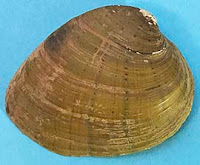Freshwater bivalves (clams), which are commonly referred to as
freshwater “mussels,” are found in rivers, streams, and lakes throughout the
world. Historically, they have been especially diverse in eastern North America (e.g., Tennessee,
Alabama, Georgia, North Carolina, and Viriginia). In the 1800’s, their shells
were used for making “pearly buttons” because the interiors of their shells are
irisdescent (having rainbow-like colors).
This post highlights three examples of extant freshwater
clams. They belong to the bivalve
family Unionidae, which has a geologic record extending into the Mesozoic.
Shells belonging to this family (the unionids) are characterized by having a
thin, brown to dark green external shell layer (periostracum) and a much
thicker, beautifully iridescent interior shell layer (nacreous layer). The
nacreous layer is commonly not preserved, however, in geologically older
shells. The outer layer helps protect the shell from acidic waters. Their
hinges, like the overall shell, is solid, heavy, and bearing prominent
dentition (teeth).
Plagiola lineolata, eastern North America. This species ranges from the Pleistocene to Recent. These first two views are right-valve exterior and interior of a specimen with length 5.3 cm and height 4.1 cm. Note the iridescence of the interior of the valve.
This view is of the right-valve interior of another specimen of P. lineolata: specimen length 8.3 cm, height 6.2 cm. The hinge of the right valve of this species has a single cardinal tooth and a single lamellar tooth on the right valve.
Quadrula quadrula
(Rafinesque, 1820), eastern North America. This is the exterior of a right valve: length 7.6 mm, height 6.6 mm. This species ranges from Pleistocene to Recent. Notice the pustules on the surface. Many unionid bivalves have pustules.
Tritogonia verrucosa Say, 1814, eastern North America. This is the exterior of a right valve: length 12.2 mm,
height 6.6 mm.
Anodonta grandis, Santa Margarita Lake, San Luis Obispo County, California. Right valve, somewhat weathered, exterior view and interior views, length 10.2 cm, height 6.5 cm. This genus is widespread in the fossil record and ranges from the Late Cretaceous to Recent. The shell of Anodonta is very thin, and the damage seen here on the exterior surface of this shell also affected the growth of the interior of the shell, in the form of small "bumps." The hinge of this species of Anodonta is much weaker than on the unionid species shown above, most likely because this Anodonta lived in quieter waters.
Freshwater bivalves can have considerable morphologic variation in their shells because of ecologic modifications and because of male and female differences.
It is also interesting to note that freshwater bivalves have a larval stage, which is parasitic in fish gills. These bivalves, therefore, can achieve rapid dispersal in river systems because of the distribution of the fish.
It is also interesting to note that freshwater bivalves have a larval stage, which is parasitic in fish gills. These bivalves, therefore, can achieve rapid dispersal in river systems because of the distribution of the fish.
In recent decades, freshwater bivalves have undergone drastic declines because of water pollution, habitat desctruction, dam construction, and exotic species introduction.







No comments:
Post a Comment